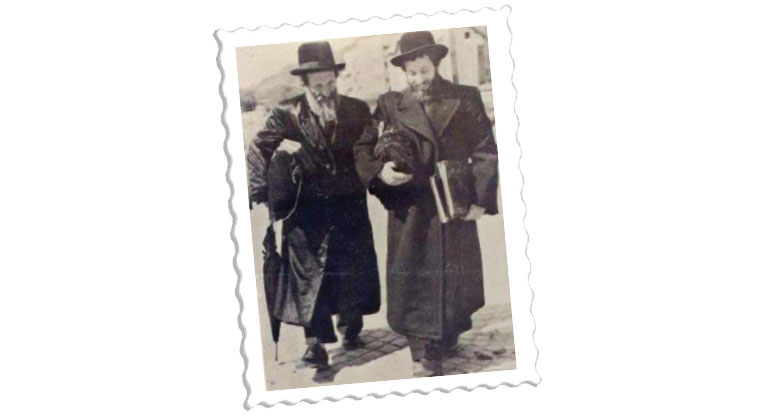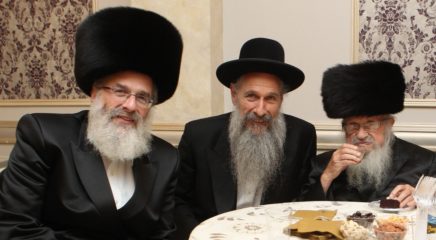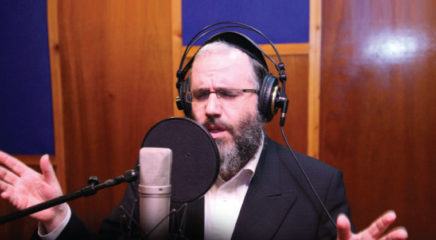A
sk someone to name a Skulener niggun, and he’s likely to point to “Yivoda Bagoyim.” One of the most famous compositions of the previous Rebbe — Rav Eliezer Zusia Portugal ztz”l — the song represents the cry of the Yid shackled in galus, tortured and imprisoned by evil enemies. (It’s been recorded on several albums, including Cantor David Werdyger’s Skulener Nigunim and MBD’s Memories.) But how many know that this song helped extract the Rebbe himself from the clutches of life-threatening torture and abuse in a Romanian Communist prison?
The Romanian People’s Republic, the Soviet-aligned Romanian state that controlled the country from 1947 to 1965, officially provided religious freedom, but in practice, promoted atheism, engaged in religious persecution, and choked and suppressed all practice of Yiddishkeit. Still, after Stalin’s death in 1953, the government began using the positions of religious leaders to improve its image internationally, and would therefore invite guests from abroad in order to showcase Romania’s provision of religious freedom and flourishing Jewish life. In 1954, Rabbi Moshe David Rosen, Romania’s chief rabbi, was asked to invite Swedish chief rabbi Dr. Kurt Wilhelm to Bucharest. Rabbi Wilhelm, who had been educated at Oxford and at several German universities, was an influential personality in Sweden’s halls of power.
In honor of his visit, the authorities invited all the rabbis in Romania to a ceremonial Saturday night dinner in Bucharest. Nonattendance would have been interpreted as disloyalty to the Republic, so the rabbanim were forced to come to the capital for Shabbos. Some of them stayed with the Skulener Rebbe, who had initially moved from Skulen to Chernowitz before World War II and then, after being tortured by both the Russians and the Germans, escaped to Bucharest with dozens of orphans in the middle of World War II. In the years since, although the Communist authorities gave him permission to emigrate, he continued to care for the thousands of orphans and Jewish families still in Romania, teaching Torah under the Communist radar. On Motzaei Shabbos, the Rebbe’s guests davened Maariv and left for the banquet. The Rebbe himself did not hurry though, but followed his custom of presiding over a lengthy Shalosh Seudos tish and arrived at the dinner two hours later.
At the head table sat Chief Rabbi Rosen, Rabbi Kurt Wilhelm and some Romanian government officials. There was a respectful silence as the Rebbe entered and was brought up to the dais. He sat down next to Rabbi Rosen, who had great respect for the Rebbe. Rabbi Wilhelm saw the Rebbe, short in stature, frail, bent, and weak looking, wearing an ancient shtreimel, and quietly asked Rabbi Rosen who this person was. The Romanian chief rabbi replied, “He has a weak body, but a healthy spirit. This man is the most spiritual person in Romania.”
The speeches began. One after the other, the rabbinic personalities and activists spoke about how good life was for the Jews in Romania and praised the humanitarianism of the Communist government. Not a hint about the unfortunate Jews who had been arrested, or all the community’s shochtim, who were languishing in jail. The Rebbe was then honored with a speech too. Standing up, he apologized that he wasn’t much of a speaker, but would instead sing a song that he had composed especially for the honored guest. (The Rebbe was known as a tremendous baal menagein, and dozens of his niggunim, and those of his son, the present Rebbe, are still sung today.)
The niggun he wrote was for the pesukim of Tehilim 79. “Yivoda bagoyim… Let it be known among the nations… the avengement of Your servants’ spilt blood. Let the cry of the imprisoned come before You, according to the strength of Your Hand, release those condemned to death. And return to our enemies sevenfold their abuse, which they have abused You, Hashem,” sang the Rebbe in a broken voice to a room full of Jewish rabbis — and Communist comrades.
Afterward, Rabbi Wilhelm commented that the song was the best speech of the night. It revealed the true suffering of the trapped Romanian Jews, without the government being any the wiser. He returned to Sweden with a clearer understanding of the situation, but it was five years before he was able to help in any way.
Meanwhile, the Skulener Rebbe continued his holy work unabated. Besides adopting and taking care of the many war orphans in Bucharest, he supported any Jewish family whose breadwinner was imprisoned. These unfortunates were avoided by everyone, lest they too be incriminated by association, but the Rebbe had no such fear. He traveled around Romania, spending Shabbos in different villages in order to strengthen the small communities, holding tishen with inspiring speeches and powerful niggunim. During this period, there was a small yeshivah in the western Romanian city of Arad, which the government allowed to exist with a few students, but through the efforts of the Skulener Rebbe, dozens more boys joined and were taught Torah.
The government initially hesitated to arrest the Rebbe, fearful of condemnation from the free world. But when they saw that he continued to fan the flames of Yiddishkeit among the people and no amount of harassment would stop him, they accused him of trying to undermine the government because of his support and adoption of orphans. On the night of Rosh Chodesh Nissan 1959, Romanian authorities burst into the Portugal home and hauled both the Rebbe and his son, Rav Yisrael Avraham — the current Rebbe — to jail.
Interrogation followed interrogation. With torture and violence, the Romanians tried to get the Rebbe to admit to the crime of smuggling orphans into Israel and of being an American spy, and to implicate other members of the Jewish community. At one point, today’s Rebbe once related, they tore his beard and peyos so brutally that he thought he might die of pain. He asked them to stop because he wanted to say something, so they excitedly granted him a reprieve, expecting a confession. He told them, “I have nothing to confess, but my final request to you is to allow me to be buried as a Jew.” Needless to say, the tortures soon resumed.
The news of the Skulener Rebbe’s capture spread to the free world through Rav Tzvi Bronstein of the Al Tidom movement, which supported Jews behind the Iron Curtain. A committee was convened in New York, together with Rav Tzvi Yosef Misky and Rav Shlomo Zalman Horwitz, to work on his release. At one point, the committee discovered that the Romanian People’s Republic wanted an economic favor from the United Nations. They also found out that Rabbi Kurt Wilhelm, chief rabbi of Sweden, was a close friend of Dag Hammarskj?ld, the UN Secretary-General, from their time together at Oxford University.
Upon the advice of the Satmar Rebbe, who gave a large donation for this mitzvah of pidyon shevuyim and offered the committee great encouragement, they contacted Mr. Aharon (Harry) Goodman, a well-known Agudah askan from London, who knew Rabbi Wilhelm and agreed to contact him.
A phone call to Sweden revealed that the rabbi was actually in London. It was late at night, but Harry Goodman wasted no time in reaching him there. Apologizing for the disturbance, he told Rabbi Wilhelm that a well-known chassidic rabbi was imprisoned under terrible conditions in Romania. “You have probably never heard of him, but he’s well-known and beloved in chassidic circles.”
“What is the rabbi’s name?” asked Rabbi Wilhelm.
“Rabbi Portugal.”
At this, the Swedish rabbi started to cry. “Rabbi Portugal is my own rebbe!” He immediately called home with a change of plans: He’d be flying directly to New York instead of returning to Sweden. A meeting with Dag Hammarskj?ld influenced him to apply pressure to the Romanian government to release the Skulener Rebbe, and the efforts bore fruit. The Rebbe and his son were released from jail five months later. When the Rebbe arrived home, his family and adopted children didn’t even recognize him because of the torture he had undergone. Yet true to the words of his most enduring song, Hashem indeed avenged His shame.
The Skulener Rebbe continued his rescue and outreach efforts after arriving in America in 1960, and traveled to Eretz Yisrael many times to oversee the continuation of his work in the Chesed L’Avraham educational network he created. And although over 25 years have passed since his petirah on 29 Av 1982, the Jewish world is still singing his song of trust for better times. (Originally featured in Mishpacha, Issue 719)





